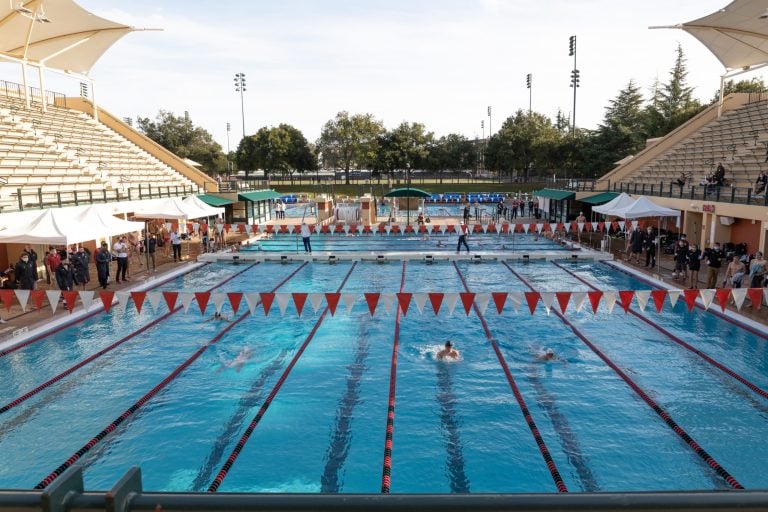Athletes recruited to Stanford, one of the nation’s most competitive athletic programs with regular NCAA championship wins and several Olympians, are used to being the best of the best at home. But for some, that exact talent pool turns dreams into dismay after they arrive on the Farm.
“When you get to Stanford, you are no longer the best at anything,” former beach volleyball player Zeena Khazendar ’23 said. Like for many Stanford athletes, Khazendar’s high school teammates and coaches regularly praised her potential as an athlete, and she was always a starting player.
“For a lot of athletes, being one of the best in their sport was a part of their identity in high school,” she said. “They lose that title at Stanford.”
During her frosh year, Khanzendar felt that her team was just competing against one another. “We were jealous of each other,” she said. “Even though some of my closest friends in the world were on that team, I found myself wishing for their failure because I wanted to be at the top.”
Khazendar recalled her emotions being “completely controlled” by what her coach thought of her, and she would catch herself telling white lies to her coaches and friends from home about how much playing time she got. Slowly, she felt herself losing her love for beach volleyball amid feelings of failure.
“Every single class of freshmen that I would see come in, I would just slowly see them lose any sort of love or passion,” Khazendar said. She believes that it wasn’t until her team began focusing less on results and more on their love for the sport that their rankings improved.
Former water poloist Alexis Rowell ’23 shared a similar sentiment about the pressure she felt coming into Stanford athletics. She spent her last few weeks of high school bonding with her teammates from home, and just one week later, she found herself amongst world-renowned athletes competing in China, and then in a starting position as a freshman. This rapid transition took a toll on her mentally and physically.
“I was the slowest person on the team.” Rowell said. “I continued to be the slowest person on the team for the entire year, and like, by, like a pretty decent margin. That definitely affected me.”
Rowell recalled that she “lost a ton of weight” and “was tired all the time” that year.
Through making more friends on the team and finding her support system, she was able to overcome burnout. Looking back, she found it hard to believe she “did all these test sets and didn’t literally collapse. I almost did my freshman year, but I could totally [get through] my senior year because I had people around me — the pressure wasn’t as bad.”
Stress played a major role in the first half of Khazendar’s and Rowell’s Stanford experiences, but football player James Pogorelc ’24 said that this “kind of comes with the territory.”
Pogorelc said he knew everything was going to move a lot quicker when he made the transition from high school to PAC-12 football. “Everyone’s going to be a lot bigger, faster and stronger,” he said. “So, maybe it was a little bit of an adjustment then but, overall, [it] wasn’t too bad.”
However, integrating into Stanford beyond athletics was a different story for Pogorelc.
“In my experience, some of the students may treat you differently, just because you’re an athlete,” he said. “[They] may think that maybe you’re not as intelligent or that you don’t belong. And I think it is interesting — I do think a bit of a label gets placed on you for being an athlete, especially sports like football and basketball.”
Khazendar expressed similar feelings and shared that she made an active effort to integrate herself into non-athlete settings such as common dining halls to diversify her social sphere. “I was expecting [non-athletes] to be like, ‘You’re the worst because you didn’t get in on your own,’ but I definitely didn’t feel that.”
Khazendar said she had a unique experience though, due to the lack of in-person interactions brought on by the COVID-19 pandemic. “All the classes below me — they really struggled to have any non-athlete friends,” she said, adding that she feels that current athletes don’t join non-athletic social spheres due to fear they’ll be outcasts. “Athletes are just kind of in a bubble together.”
One study shows that athletes at elite colleges are more likely to be socially and culturally isolated from campus, which can come with mental health drawbacks. This isolation can create circumstances in which athletes are unaware of the mental health services and communities they have available to them. Mehak Chopra, clinical assistant professor in psychiatry and behavioral sciences, pointed out there are several ongoing initiatives at Stanford aimed at improving athletes’ mental health.
“We [are] always willing to grow/learn and incorporate feedback from athletes as to how [we can] better help/support them,” Chopra wrote in a statement to The Daily. “Our attempt has always been to help provide all the resources needed by the athletes.” Chopra said her department could also make an effort to host more awareness events to make athletes aware of their services.
Offering feedback on what coaches can do to relieve the pressure put on athletes, Khazendar suggested that they need to do a better job promoting sports psychology and therapy, as she herself greatly benefitted from their service. Khazendar also emphasized that there needs to be more conversations among teammates about shaming and individual struggles in sports.
“There needs to be more conversation about how mentally challenging athletics can be,” Khazendar said. “A lot of top athletes reach that ‘top’ and they don’t find much. They just find emptiness.”
